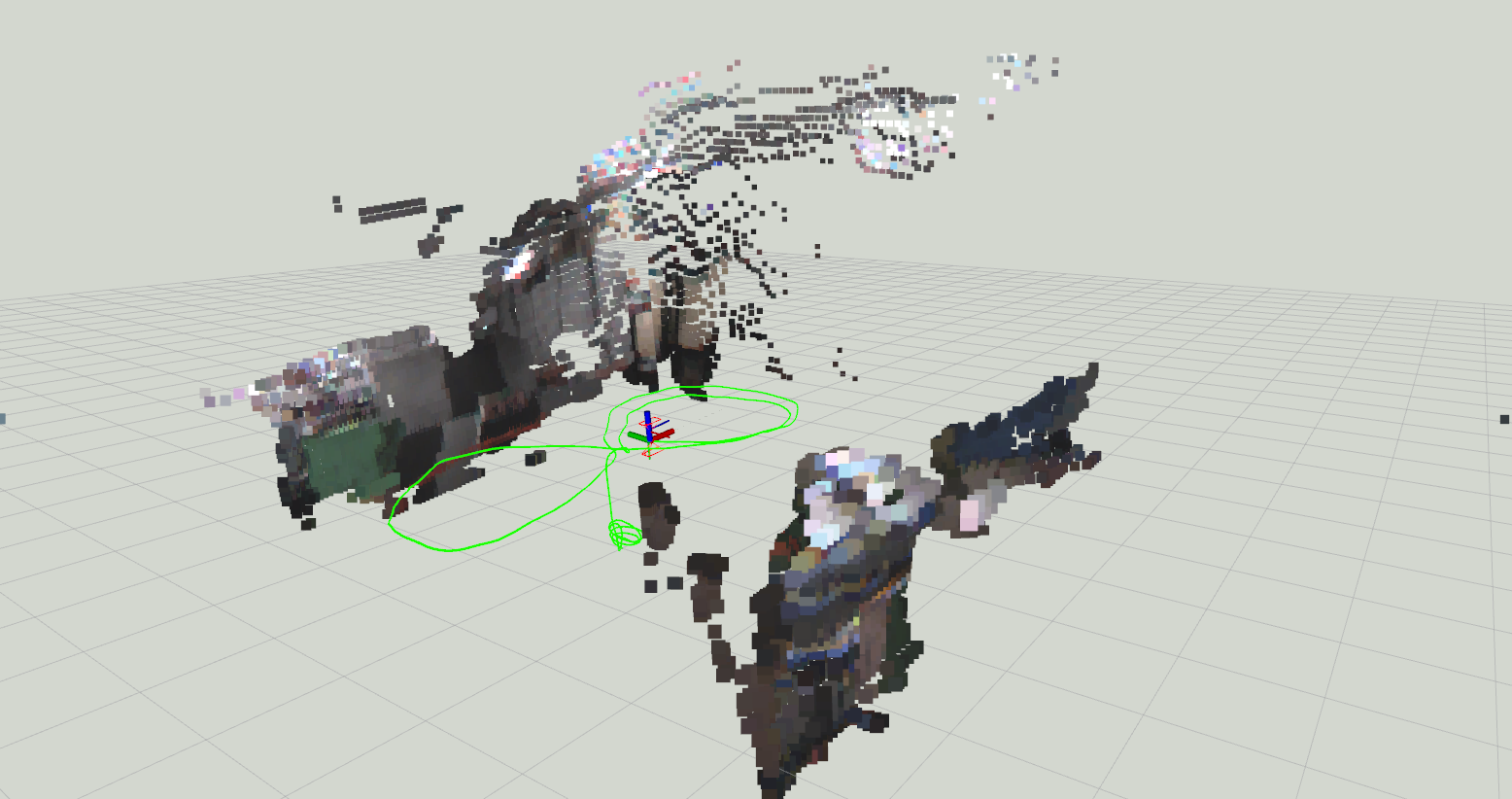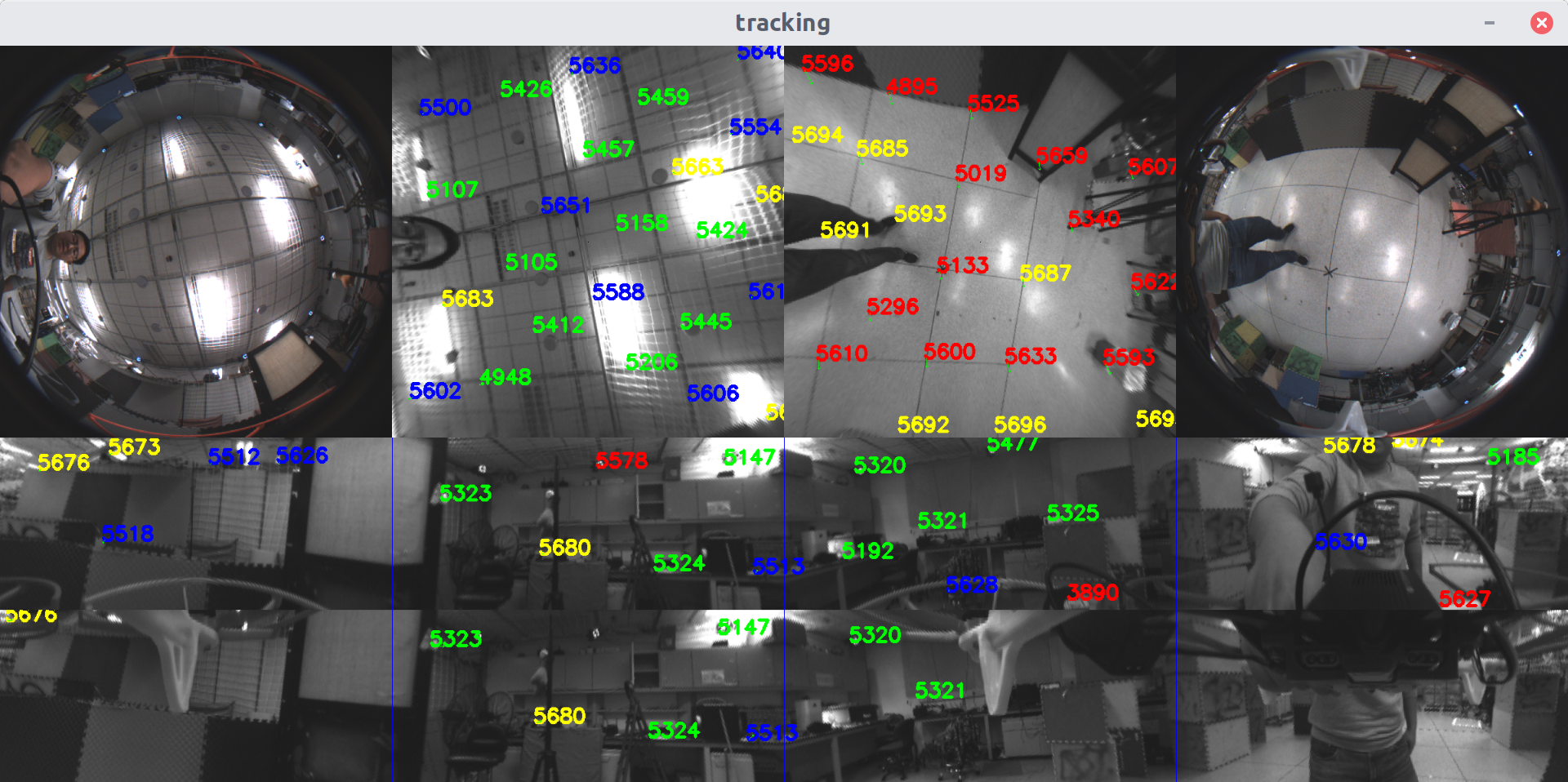This repository is a version of VINS-Fusion with Dual Fisheye and GPU and Visionworks acceleration. It can run on Nvidia TX2 in real-time, also provide depth estimation based on fisheye.
 Drone path and RGB point cloud estimation
Drone path and RGB point cloud estimation
 Disparity estimation for depth estimation
Disparity estimation for depth estimation
The essential software environment is same as VINS-Fusion. Besides, it requires OpenCV cuda version.(Only test it on OpenCV 3.4.1). Visionworks: Optional
Compile and install opencv 3.4 with CUDA to /usr/local/
If you don't have visionworks, please
set(ENABLE_VWORKS false)
If you are using visionworks, please config the visionworks sample path
include_directories(
/home/xuhao/VisionWorks-1.6-Samples/nvxio/include
)
link_directories(/home/xuhao/VisionWorks-1.6-Samples/libs/x86_64/linux/release/)in file vins_estimator/CMakeLists.txt
Term 0
roscore
Term 1
rosrun vins vins_node ~/your_ws/src/VINS-Fusion-Fisheye/config/fisheye_ptgrey_n3/fisheye.yaml
Term 2
rosbag play fishey_vins_2020-01-30-10-38-14.bag --clock -s 12
Term 3(for visuallization only)
roslaunch vins vins_rviz.launch
For rosbag, you can download from https://www.dropbox.com/s/oukwohva7ba381d/fishey_vins_2020-01-30-10-38-14.bag?dl=0
depth_config: "depth_cpu.yaml" # config path for depth estimation, depth_cpu.yaml uses opencv SGBM, depth.yaml uses visionworks SGM, you must install visionworks before use visionworks sgm
image_width: 600 # For fisheye, this indicate the flattened image width; min 100; 300 - 500 is good for vins
fisheye_fov: 235 # Your fisheye fov
enable_up_top: 1 #Choose direction you use
enable_down_top: 1
enable_up_side: 1
enable_down_side: 1
enable_rear_side: 1
thres_outlier : 5.0 # outlier thres for backend
tri_max_err: 3.0 #outlier thres for triangulate
depth_estimate_baseline: 0.05 # mini baseline for pts initialization
top_cnt: 30 #number of track point for top view
side_cnt: 30 #number of track point for side view
max_solve_cnt: 30 # Max Point for solve; highly influence performace
show_track: 0 # if display track
use_vxworks: 0 #use vision works for front-end; not as stable as CUDA now
enable_depth: 1 # If estimate depth cloud; only available for dual fisheye now
rgb_depth_cloud: 0 # -1: point no texture, 0 depth cloud will be gray, 1 depth cloud will be colored;
#Note that textured and colored depth cloud will slow down whole systemParameter for depth estimation
#choose the depth you want estimate
enable_front: 1
enable_left: 1
enable_right: 1
enable_rear: 0
#downsample ration
downsample_ratio: 0.5
#choose use cpu or visionworks
use_vworks: 0
#Publish cloud jump step
pub_cloud_step: 1
#If show dispartity
show_disparity: 0
#If publish depth map image
pub_depth_map: 1
#Publish cloud in radius
depth_cloud_radius: 10
#If publish all depth cloud in a topic
pub_cloud_all: 1
#If publish all depth cloud in every direction
pub_cloud_per_direction: 0
VINS-Fusion is an optimization-based multi-sensor state estimator, which achieves accurate self-localization for autonomous applications (drones, cars, and AR/VR). VINS-Fusion is an extension of VINS-Mono, which supports multiple visual-inertial sensor types (mono camera + IMU, stereo cameras + IMU, even stereo cameras only). We also show a toy example of fusing VINS with GPS. Features:
- multiple sensors support (stereo cameras / mono camera+IMU / stereo cameras+IMU)
- online spatial calibration (transformation between camera and IMU)
- online temporal calibration (time offset between camera and IMU)
- visual loop closure
We are the top open-sourced stereo algorithm on KITTI Odometry Benchmark (12.Jan.2019).
Authors: Tong Qin, Shaozu Cao, Jie Pan, Peiliang Li, and Shaojie Shen from the Aerial Robotics Group, HKUST
Videos:
Related Papers: (papers are not exactly same with code)
-
A General Optimization-based Framework for Local Odometry Estimation with Multiple Sensors, Tong Qin, Jie Pan, Shaozu Cao, Shaojie Shen, aiXiv pdf
-
A General Optimization-based Framework for Global Pose Estimation with Multiple Sensors, Tong Qin, Shaozu Cao, Jie Pan, Shaojie Shen, aiXiv pdf
-
Online Temporal Calibration for Monocular Visual-Inertial Systems, Tong Qin, Shaojie Shen, IEEE/RSJ International Conference on Intelligent Robots and Systems (IROS, 2018), best student paper award pdf
-
VINS-Mono: A Robust and Versatile Monocular Visual-Inertial State Estimator, Tong Qin, Peiliang Li, Shaojie Shen, IEEE Transactions on Robotics pdf
If you use VINS-Fusion for your academic research, please cite our related papers. bib
Ubuntu 64-bit 16.04 or 18.04. ROS Kinetic or Melodic. ROS Installation
Follow Ceres Installation.
Clone the repository and catkin_make:
cd ~/catkin_ws/src
git clone https://github.com/HKUST-Aerial-Robotics/VINS-Fusion.git
cd ../
catkin_make
source ~/catkin_ws/devel/setup.bash
(if you fail in this step, try to find another computer with clean system or reinstall Ubuntu and ROS)
Download EuRoC MAV Dataset to YOUR_DATASET_FOLDER. Take MH_01 for example, you can run VINS-Fusion with three sensor types (monocular camera + IMU, stereo cameras + IMU and stereo cameras). Open four terminals, run vins odometry, visual loop closure(optional), rviz and play the bag file respectively. Green path is VIO odometry; red path is odometry under visual loop closure.
roslaunch vins vins_rviz.launch
rosrun vins vins_node ~/catkin_ws/src/VINS-Fusion/config/euroc/euroc_mono_imu_config.yaml
(optional) rosrun loop_fusion loop_fusion_node ~/catkin_ws/src/VINS-Fusion/config/euroc/euroc_mono_imu_config.yaml
rosbag play YOUR_DATASET_FOLDER/MH_01_easy.bag
roslaunch vins vins_rviz.launch
rosrun vins vins_node ~/catkin_ws/src/VINS-Fusion/config/euroc/euroc_stereo_imu_config.yaml
(optional) rosrun loop_fusion loop_fusion_node ~/catkin_ws/src/VINS-Fusion/config/euroc/euroc_stereo_imu_config.yaml
rosbag play YOUR_DATASET_FOLDER/MH_01_easy.bag
roslaunch vins vins_rviz.launch
rosrun vins vins_node ~/catkin_ws/src/VINS-Fusion/config/euroc/euroc_stereo_config.yaml
(optional) rosrun loop_fusion loop_fusion_node ~/catkin_ws/src/VINS-Fusion/config/euroc/euroc_stereo_config.yaml
rosbag play YOUR_DATASET_FOLDER/MH_01_easy.bag
Download KITTI Odometry dataset to YOUR_DATASET_FOLDER. Take sequences 00 for example, Open two terminals, run vins and rviz respectively. (We evaluated odometry on KITTI benchmark without loop closure funtion)
roslaunch vins vins_rviz.launch
(optional) rosrun loop_fusion loop_fusion_node ~/catkin_ws/src/VINS-Fusion/config/kitti_odom/kitti_config00-02.yaml
rosrun vins kitti_odom_test ~/catkin_ws/src/VINS-Fusion/config/kitti_odom/kitti_config00-02.yaml YOUR_DATASET_FOLDER/sequences/00/
Download KITTI raw dataset to YOUR_DATASET_FOLDER. Take 2011_10_03_drive_0027_synced for example. Open three terminals, run vins, global fusion and rviz respectively. Green path is VIO odometry; blue path is odometry under GPS global fusion.
roslaunch vins vins_rviz.launch
rosrun vins kitti_gps_test ~/catkin_ws/src/VINS-Fusion/config/kitti_raw/kitti_10_03_config.yaml YOUR_DATASET_FOLDER/2011_10_03_drive_0027_sync/
rosrun global_fusion global_fusion_node
Download car bag to YOUR_DATASET_FOLDER. Open four terminals, run vins odometry, visual loop closure(optional), rviz and play the bag file respectively. Green path is VIO odometry; red path is odometry under visual loop closure.
roslaunch vins vins_rviz.launch
rosrun vins vins_node ~/catkin_ws/src/VINS-Fusion/config/vi_car/vi_car.yaml
(optional) rosrun loop_fusion loop_fusion_node ~/catkin_ws/src/VINS-Fusion/config/vi_car/vi_car.yaml
rosbag play YOUR_DATASET_FOLDER/car.bag
VIO is not only a software algorithm, it heavily relies on hardware quality. For beginners, we recommend you to run VIO with professional equipment, which contains global shutter cameras and hardware synchronization.
Write a config file for your device. You can take config files of EuRoC and KITTI as the example.
VINS-Fusion support several camera models (pinhole, mei, equidistant). You can use camera model to calibrate your cameras. We put some example data under /camera_models/calibrationdata to tell you how to calibrate.
cd ~/catkin_ws/src/VINS-Fusion/camera_models/camera_calib_example/
rosrun camera_models Calibrations -w 12 -h 8 -s 80 -i calibrationdata --camera-model pinhole
We use ceres solver for non-linear optimization and DBoW2 for loop detection, a generic camera model and GeographicLib.
The source code is released under GPLv3 license.
We are still working on improving the code reliability. For any technical issues, please contact Tong Qin <qintonguavATgmail.com>.
For commercial inquiries, please contact Shaojie Shen <eeshaojieATust.hk>.







